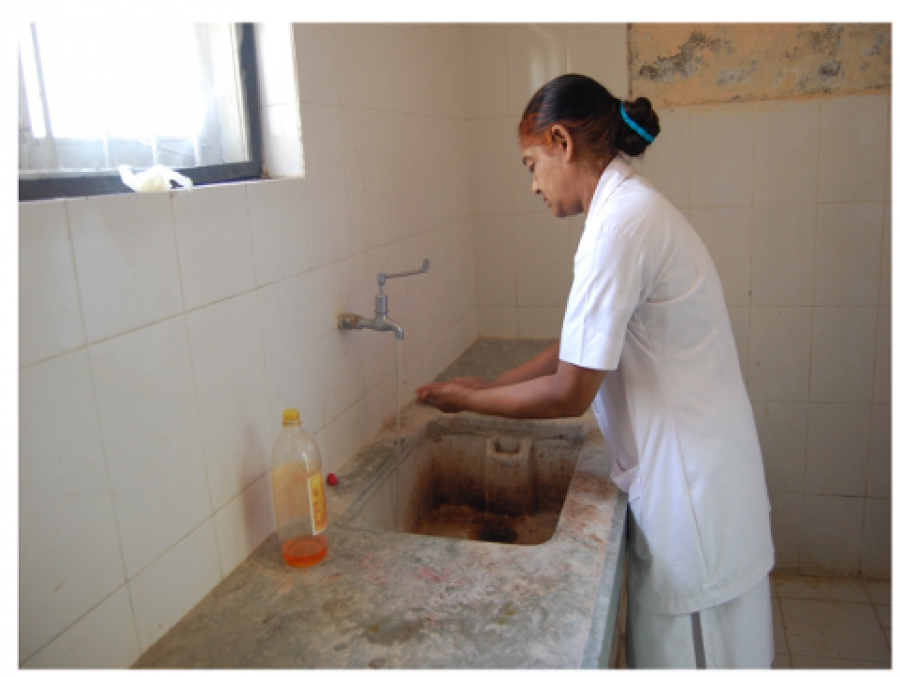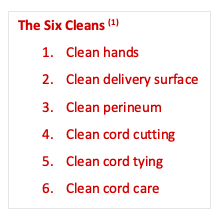
A decade on from the Clean Birth Kits Policy Briefing, the six cleans(1) are now more important than ever to keep mothers and babies safe during the COVID-19 pandemic.
Though the exact impact of COVID-19 on mothers and newborns is not yet clear, pregnant women may be at greater risk of acquiring COVID-19 because of their vulnerability to respiratory viruses(2). Cases of neonatal infection further highlight the importance of considering pregnant women and newborns as at-risk populations in strategies to prevent and manage the infection(3). You can learn more about COVID-19 and pregnancy in our podcast episode with Prof Joy Lawn.
Hand hygiene is considered to be one of the most important behaviours to prevent the transmission of healthcare associated infections(4). Hand washing, in both the public and healthcare settings, has been pushed as a method to fight covid-19 through the WHO's Safe Hands Campaign(5). We also know that clean hands, the first of the six cleans, are especially important in preventing maternal and neonatal infections(6). Yet, in their time-and motion-study, Gon and colleagues(7)found that across the 10 busiest labour wards in Zanzibar, hand hygiene compliance at birth by birth attendants before undertaking an aseptic procedure was poor. Birth attendants hand rubbed/washed in only 24.6% hand hygiene opportunities and risked re-contaminating their hands or gloves in 45.3% of opportunities.
Environmental cleaning also has a vital role in protecting mothers and newborns from infection, as demonstrated by the second of the six cleans: clean delivery surface(6). Not only is having a clean delivery surface critical, but ensuring the patient care environment is clean is vital in the context of COVID-19 as the virus causing the infection can survive on surfaces for up to several days(8). As such, healthcare facilities must ensure thorough and frequent cleaning of labour wards and equipment.
On the International Day of the Midwife and Global Hand Hygiene Day, 5thMay 2020, we must support midwives, nurses and all healthcare workers to ensure women and newborns receive safe and clean care. Policy makers and IPC leaders must also take responsibility for creating the means to empower nurses and midwives in protecting their patients and themselves.
References
- Blencowe, H., Lawn, J. and Graham, W. (2010) Clean birth kits - potential to deliver? Evidence experience, estimated lives saved and cost.Save the Children and Immpact.
- Qiao, J. (2020) ‘What are the risks of COVID-19 infection in pregnant women?’, The Lancet. Lancet Publishing Group, pp. 760–762. doi: 10.1016/S0140-6736(20)30365-2.
- Lotfinejad, N., Peters, A. and Pittet, D. (2020) ‘Hand hygiene and the novel coronavirus pandemic: The role of healthcare workers’, Journal of Hospital Infection. doi: 10.1016/j.jhin.2020.03.017.
- Luangasanatip, N. et al.(2015) ‘Comparative efficacy of interventions to promote hand hygiene in hospital: Systematic review and network meta-analysis’, BMJ. doi: 10.1136/bmj.h3728.
- WHO | Infection prevention and control | SAVE LIVES: Clean Your Hands 5 May 2020(2020). Available at: https://www.who.int/infection-prevention/en/ (Accessed: 4 May 2020).
- Blencowe, H. et al.(2011) ‘Clean birth and postnatal care practices to reduce neonatal deaths from sepsis and tetanus: A systematic review and Delphi estimation of mortality effect’, BMC Public Health. BioMed Central, p. S11. doi: 10.1186/1471-2458-11-S3-S11.
- Gon, G. et al.(2019) ‘Hands washing, glove use, and avoiding recontamination before aseptic procedures at birth: A multicenter time-and-motion study conducted in Zanzibar’, American Journal of Infection Control. Mosby Inc., 47(2), pp. 149–156. doi: 10.1016/j.ajic.2018.07.021.
- Van Doremalen, N. et al.(2020) ‘Aerosol and Surface Stability of SARS-CoV-2 as Compared with SARS-CoV-1’, The New England journal of medicine. NLM (Medline), pp. 1564–1567. doi: 10.1056/NEJMc2004973.
Our postgraduate taught courses provide health practitioners, clinicians, policy-makers, scientists and recent graduates with a world-class qualification in public and global health.
If you are coming to LSHTM to study a distance learning programme (PG Cert, PG Dip, MSc or individual modules) starting in 2024, you may be eligible for a 5% discount on your tuition fees.
These fee reduction schemes are available for a limited time only.

